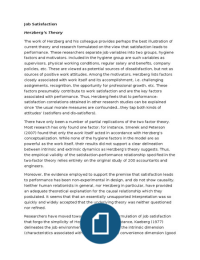Job Satisfaction
Herzberg’s Theory
The work of Herzberg and his colleague provides perhaps the best illustration of
current theory and research formulated on the view that satisfaction leads to
performance. These researchers separate job variables into two groups, hygiene
factors and motivators. Included in the hygiene group are such variables as
supervisors, physical working conditions, regular salary and benefits, company
policies, etc. These are viewed as potential sources of dissatisfaction, but not as
sources of positive work attitudes. Among the motivators, Herzberg lists factors
closely associated with work itself and its accomplishment, i.e. challenging
assignments, recognition, the opportunity for professional growth, etc. These
factors presumably contribute to work satisfaction and are the key factors
associated with performance. Thus, Herzberg feels that lo performance-
satisfaction correlations obtained in other research studies can be explained
since ‘the usual morale measures are confounded...they tap both kinds of
attitudes’ (satisfiers and dis-satisfiers).
There have only been a number of partial replications of the two factor theory.
Most research has only found one factor; for instance, Smerek and Peterson
(2007) found that only the work itself acted in accordance with Herzberg’s
conceptualization. While none of the hygiene factors in the model are as
powerful as the work itself, their results did not support a clear delineation
between intrinsic and extrinsic dynamics as Herzberg’s theory suggests. Thus,
the empirical validity of the satisfaction-performance relationship specified in the
two-factor theory relies entirely on the original study of 200 accountants and
engineers.
Moreover, the evidence employed to support the premise that satisfaction leads
to performance has been non-experimental in design, and do not show causality.
Neither human relationists in general, nor Herzberg in particular, have provided
an adequate theoretical explanation for the causal relationship which they
postulated. It seems that that an essentially unsupported interpretation was so
quickly and widely accepted that the underlying theory was neither questioned
nor refined.
Researchers have moved towards more complex formulation of job satisfaction
that forgo the simplicity of Herzberg’s theory. For instance, Kaeberg (1977)
delineates the job environment into six dimensions: the intrinsic dimension
(characteristics associated with the task itself), the convenience dimension (good
, hours, pleasant physical surroundings, and convenient travel), financial (pay,
fringe benefits, job security), relationships with co-workers (whether there are
chances to meet friends and meet social needs), career (whether the chances for
a promotion are good), and resource adequacy (whether there is enough help
and information required to complete the job). This reflects Thorngate’s postulate
that it is impossible for a theory of social behaviour to be simultaneously general,
accurate and simple. Researchers can secure only two of the three virtues, but
automatically concede the third.
Motivation
The concept of motivation refers to internal factors that impel action and to
external factors that can act as inducement to action. Motivation can affect not
only the acquisition of people’s skills and abilities but also how and to what
extent they utilize their skills and abilities.
Work Motivation Theories
Maslow’s (1943) hierarchical need theory
There is a resurgence of interest in Maslow’s hierarchy. Wicker et al. (1993)
showed that between-goal correlations and partial correlations across four
samples of college students supported Maslow’s theory when intentions to act
were rated rather than measures of importance. Ronen (2001) using multi-
dimensional scaling of employee data collected in 15 countries rather than
analysis, found support for the taxonomic element of Maslow’s theory. Kluger and
Tikochinsky (2001) advocated ongoing efforts to find ways to operationalize the
theory validity.
The practical significance of Maslow’s theory is widely accepted - refer. In the
work setting, Maslow’s model has the same five levels, but the definitions were
modified by Maslow himself. At the base, the first level that must be satisfied is
that of wages. Maslow posited that if individuals are, in their minds, fairly paid,
they will not spend an inordinate amount of time thinking about their salaries.
Conversely, if an individual does not believe that he/she is being paid a fair
wage, too much time will be spent contemplating this perceived inequity and
other work concerns will not be given the attention that might be required. This
is a correlation between the traditional model and that found in the work
environment. Basic survival needs must be met with wages which in turn provide
shelter, food, water, heat, clothing, etc. With adequate wages, the individual
seeks safety on the job. This includes not only physical, but mental safety. A




